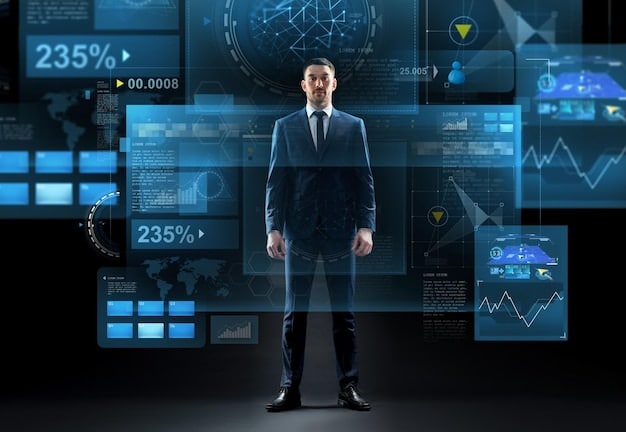US Businesses: Are You Ready for the Metaverse Workplace Revolution?

The metaverse workplace represents an evolution of remote work, offering immersive and interactive virtual environments that could redefine collaboration, training, and employee engagement strategies for businesses across the US, requiring strategic foresight and technological adaptation.
As technology continues its rapid advancement, the concept of a future where virtual and augmented realities seamlessly blend with our professional lives is no longer confined to science fiction. For US businesses, the question is becoming increasingly pertinent: Are you ready for the Metaverse Workplace Revolution? This emerging paradigm promises to reshape how companies operate, fostering unprecedented levels of collaboration and innovation, but it also presents a unique set of challenges that demand careful consideration and proactive planning.
Understanding the Metaverse Workplace: Beyond Basic VR
The metaverse workplace extends far beyond simple video conferencing or even current virtual reality applications. It envisions persistent, shared, and interactive 3D digital spaces where employees, regardless of their physical location, can gather, communicate, collaborate, and perform tasks as if they were in the same physical office. This immersive environment has the potential to overcome many of the limitations associated with traditional remote work, fostering a stronger sense of presence and connection among distributed teams. It’s a strategic shift that could fundamentally alter organizational structures and operational workflows, demanding a new level of technological integration and human-computer interaction.
Defining the Core Components
At its heart, the metaverse workplace relies on several key technological pillars that integrate to create a comprehensive digital ecosystem. These components work in concert to deliver an experience that feels both intuitive and deeply engaging, breaking down geographical barriers and enabling more fluid interactions.
- Persistent Virtual Worlds: Unlike temporary meeting rooms, these spaces exist continuously, allowing users to return to ongoing projects and environments.
- Avatars and Digital Identity: Employees interact through customizable digital representations, fostering a sense of self and presence within the virtual space.
- Immersive Technologies: VR headsets and AR glasses provide varied levels of immersion, enhancing visual and auditory experiences.
- Interoperability: The ability for different platforms and tools to communicate and share assets will be crucial for a seamless experience.
This combination of elements means that a virtual meeting can feel less like a grid of faces and more like a gathering in a sophisticated, shared environment. It offers possibilities for immediate feedback, non-verbal cues, and spatial awareness that are often lost in conventional digital communication methods. Early adopters are beginning to experiment with these capabilities, revealing both the promise and the complexities involved in their deployment.
Historical Trajectory and Future Projections
The journey to the metaverse workplace is a culmination of decades of technological development, from early online communities to current sophisticated VR systems. We have seen a steady progression from text-based interactions to rich multimedia experiences, with each step paving the way for greater immersion. Initially, the focus was often on entertainment and social networking, but the underlying technologies have always held immense potential for professional applications.
As we look towards the future, projections suggest significant growth in the enterprise metaverse sector. Analyst firms predict multi-trillion-dollar valuations for the metaverse industry within the next decade, with a substantial portion dedicated to professional applications. This growth will be driven by advancements in hardware, network infrastructure, and increasingly sophisticated software solutions tailored for business needs. The implications for productivity, training, and global team management are profound, suggesting a future where geographical location becomes an even smaller barrier to collaboration and innovation. Businesses that proactively engage with this evolving landscape will be better positioned to capitalize on its transformative potential, while those that delay might find themselves struggling to catch up with new operational norms.
Operational Efficiencies: The Metaverse Advantage
The shift towards a metaverse workplace holds considerable potential for enhancing operational efficiencies across various business functions for US enterprises. By creating immersive and interactive virtual environments, companies can streamline processes, reduce costs, and accelerate project timelines. This paradigm offers new avenues for resource optimization and fosters a more agile and responsive organizational structure, moving beyond the traditional constraints of physical workplaces. The integration of advanced analytics and AI within these virtual spaces can further amplify these efficiencies, providing real-time insights into performance and collaboration metrics.
Enhanced Collaboration and Communication
One of the most compelling advantages of the metaverse workplace is its capacity to revolutionize collaboration and communication. Traditional remote work tools, while effective, often lack the nuanced interaction present in face-to-face meetings. The metaverse addresses this by providing a richer, more engaging environment.
- Spatial Audio and Visual Cues: Mimic real-world interactions, making conversations more natural and intuitive.
- Shared Virtual Whiteboards and 3D Models: Allow for real-time co-creation and manipulation of complex designs, fostering deeper engagement.
- Persistent Project Spaces: Teams can leave work elements in a shared virtual room, returning to them later exactly as they left them.
- Global Team Integration: Bridges geographical divides by placing all team members in a shared virtual space, regardless of their physical location.
These capabilities mean that brainstorming sessions can become more dynamic, design reviews more comprehensive, and cross-functional team projects more integrated. The virtual presence helps to build a stronger team cohesion, an element often cited as a challenge in traditional remote setups. This is particularly beneficial for US companies operating across multiple time zones or with deeply distributed global workforces.
Streamlined Training and Onboarding
Training and onboarding processes are significant investments for any company, often involving travel, physical resources, and dedicated facilities. The metaverse workplace offers an innovative solution to these challenges, making these processes more cost-effective, scalable, and engaging. New hires can be onboarded into a virtual office space, complete with interactive tutorials and simulated job tasks.
Virtual training environments can replicate dangerous or expensive real-world scenarios, allowing employees to practice skills without risk or high overhead. For instance, manufacturing firms can train technicians on complex machinery in a virtual twin environment before they ever touch physical equipment. Similarly, customer service representatives can engage in role-playing simulations with AI-powered virtual customers, sharpening their skills in a low-stakes setting. This immersive approach leads to higher retention rates of information and a more confident, prepared workforce. Moreover, companies can rapidly scale training programs to accommodate large numbers of employees across different regions, ensuring consistent quality and messaging. The ability to track progress and performance within these virtual modules also provides valuable data for refining training methodologies.
Cost Reduction and Resource Optimization
Shifting aspects of business operations to the metaverse workplace can unlock substantial cost reductions and optimize resource utilization. One of the most immediate benefits is the potential for significant savings on real estate. As more employees work in virtual spaces, the need for large, expensive physical office buildings decreases, allowing businesses to downsize or repurpose existing spaces. This translates directly into lower rental costs, utility bills, and maintenance expenses.
Beyond real estate, the metaverse can reduce travel expenses associated with client meetings, conferences, and inter-office collaborations. Instead of flying employees across the country or globally, companies can host these interactions in highly realistic and engaging virtual environments. This not only saves money but also reduces the carbon footprint, aligning with sustainability goals. Furthermore, the ability to create virtual prototypes and digital twins can dramatically cut down on physical material costs and development time in sectors like engineering and product design. Resource optimization extends to human capital, as employees can access and utilize shared virtual tools and resources more efficiently, leading to increased productivity without the need for constant physical upgrades or expansions. The long-term implications are for a leaner, more efficient operational model that prioritizes digital over physical infrastructure where appropriate.
The Human Element: Employee Experience in Virtual Realms
While the technological capabilities of the metaverse workplace are undeniably impressive, its long-term success for US businesses hinges critically on the human element – the employee experience. Transitioning to immersive virtual environments necessitates a careful consideration of how these spaces impact well-being, engagement, and productivity. Overcoming potential psychological barriers and fostering a positive, inclusive virtual culture will be paramount for widespread adoption and sustained benefits. The challenge lies in ensuring that the digital interactions enrich rather than detract from human connection and overall job satisfaction.
Addressing Digital Fatigue and Well-being
The extended use of digital collaboration tools has already introduced us to concepts like “Zoom fatigue.” The even more immersive nature of the metaverse workplace could potentially amplify these issues if not managed thoughtfully. Businesses must proactively address the risks of digital fatigue and prioritize employee well-being within virtual realms.
- Planned Breaks and Movement: Encouraging regular physical breaks from VR headsets and promoting movement within virtual spaces designed for exploration.
- Ergonomic Considerations: Ensuring comfortable and minimally intrusive VR/AR hardware, with options for varied levels of immersion.
- Mental Health Resources: Providing access to resources that address the unique psychological aspects of prolonged virtual interaction.
- Designing for “Presence,” Not Just “Immersion”: Focusing on feeling connected and effective, rather than just visually being “in” the space.
Creating virtual environments that include elements of “digital nature” or calming spaces could also contribute positively to employee mental state. Companies should consider flexible work models within the metaverse, allowing employees to switch between immersive and less immersive modes of work as needed. The goal is to maximize the benefits of immersion without overwhelming or exhausting individuals, creating a sustainable and healthy virtual work environment.
Fostering Culture and Connection
Maintaining a strong company culture and fostering meaningful connections among employees can be challenging in a distributed work setting. The metaverse workplace, however, offers unique opportunities to rebuild and amplify these critical aspects of organizational life. Beyond formal meetings, virtual spaces can host informal gatherings, team-building activities, and social events that mimic real-world interactions.
Imagine virtual lunch breaks in a digital café, company-wide celebrations in an elaborate virtual auditorium, or even casual water cooler conversations that genuinely replicate the spontaneity of office life. Avatars can embody individual personalities through customization, allowing for non-verbal communication and personal expression that builds rapport. Companies can design virtual “hangout zones” or communal spaces where employees can informally connect, share ideas, and build camaraderie. The metaverse can also enable more inclusive cultural celebrations and global team-building exercises that might be logistically impossible in the physical world. By consciously designing for social interaction and cultural expression, US businesses can leverage the metaverse to create a more vibrant, connected, and inclusive workplace culture where every employee feels seen and valued, regardless of their geographical location.
Privacy and Data Security Concerns
As work shifts into the metaverse, privacy and data security become even more complex and critical considerations for US businesses. The richness of data collected in persistent virtual environments—ranging from biometric data from VR headsets to detailed interaction logs—raises significant concerns that must be addressed with robust policies and advanced technological safeguards.
The very nature of immersive VR means that far more data about an employee’s behavior, emotional responses (via eye tracking or facial expressions on avatars), and physical movements could be collected. This necessitates clear policies on what data is collected, how it is used, and who can access it. Companies must ensure compliance with existing data protection regulations like GDPR and CCPA, and anticipate future regulations specifically addressing metaverse data. End-to-end encryption for communications, secure data storage for all virtual assets and interactions, and stringent access controls are non-negotiable. Furthermore, businesses need to educate employees on best practices for data privacy within the metaverse, including the responsible use of personal avatars and shared digital spaces. Building and maintaining trust with employees regarding their digital privacy will be paramount for successful metaverse adoption. Failing to address these concerns adequately could lead to legal challenges, reputational damage, and a breakdown of employee confidence in the new work environment.

Technological Infrastructure and Adoption Readiness
For US businesses, preparing for the metaverse workplace revolution isn’t just about conceptual understanding; it’s about practical readiness. This readiness hinges on having the appropriate technological infrastructure and a strategic approach to adoption. Companies must assess their current IT capabilities, plan for necessary upgrades, and develop clear implementation roadmaps to ensure a smooth transition into these immersive digital environments. Without a robust and scalable technical foundation, the promises of the metaverse workplace will remain largely unfulfilled. It’s a significant investment that requires careful planning and a phased approach, rather than an abrupt overhaul.
Required Hardware and Software Upgrades
The metaverse workplace demands specific hardware and software capabilities that go beyond standard office equipment. Businesses will need to invest in a range of technologies to support an immersive and interactive virtual environment.
- High-Performance VR/AR Headsets: Essential for immersive experiences, with considerations for comfort, resolution, and field of view.
- Powerful Computing Resources: Adequate GPUs and processing power are required for rendering complex 3D environments and applications.
- Robust Network Infrastructure: High-bandwidth, low-latency internet connectivity is critical to prevent lag and ensure smooth interactions within virtual spaces.
- Specialized Metaverse Platforms: Software solutions designed for enterprise collaboration, content creation, and data management within virtual worlds.
Beyond these core components, companies might also consider haptic feedback devices for more tactile interactions, and advanced audio systems for crystal-clear communication. The challenge lies not just in acquiring these technologies, but in integrating them seamlessly into existing IT ecosystems and ensuring interoperability. A phased approach to hardware rollout, perhaps starting with specific teams or departments, could help manage initial costs and identify practical challenges before a broader deployment. Companies should also explore cloud-based metaverse solutions to potentially reduce the burden of on-premise infrastructure management.
Network Bandwidth and Latency
The very foundation of a functional metaverse workplace is a robust and resilient network infrastructure. Immersive virtual environments are incredibly data-intensive, requiring significantly more bandwidth and lower latency than traditional video conferencing tools. High-fidelity 3D graphics, real-time avatar movements, spatial audio, and interactive content all contribute to a constant stream of information that must be transmitted quickly and efficiently.
Insufficient network bandwidth will lead to choppy visuals, delayed interactions, and a frustrating user experience that severely undermines the benefits of immersion. Similarly, high latency—the delay between cause and effect—can make conversations feel unnatural, collaboration tools unresponsive, and overall presence diminished. US businesses must assess their current network capabilities, including both internal Wi-Fi networks and external internet service providers (ISPs). Upgrades to fiber optics, 5G connectivity (where available), and edge computing solutions will become increasingly vital. Organizations may also need to invest in dedicated network segments for metaverse applications to prioritize traffic and ensure optimal performance. Collaborating with network providers and employing advanced network monitoring tools will be essential to guarantee a seamless and productive metaverse experience for all employees. The quality of the network often dictates the quality of the virtual interaction, making it a non-negotiable area of focus.
Interoperability and Ecosystem Development
A truly revolutionary metaverse workplace cannot exist in isolation. Its effectiveness will largely depend on its ability to interoperate with existing business applications and to support a diverse ecosystem of tools and services. The current digital landscape for businesses is fragmented, with various platforms for CRM, project management, communication, and more. The metaverse must act as an integrating layer, not another silo.
Interoperability means that data, assets, and even avatars can seamlessly move between different virtual platforms and traditional 2D applications. For example, a document created in a virtual brainstorming session should easily transfer to a traditional project management tool. This requires standardized protocols and open APIs, which are still evolving in the metaverse space. US businesses should look for metaverse platforms that prioritize open standards and offer extensive integration capabilities. Furthermore, the development of a rich ecosystem of third-party developers, content creators, and service providers will be critical. This ecosystem will deliver specialized tools, virtual meeting spaces, training modules, and creative assets that cater to specific industry needs. Companies should actively engage with this emerging ecosystem, providing feedback and even contributing to its growth to ensure that the metaverse workplace evolves in a way that truly serves their strategic objectives. This collaborative approach will accelerate the maturation of the enterprise metaverse, making it a more versatile and powerful tool for digital transformation.
Legal and Ethical Frameworks in the Metaverse
As US businesses venture into the metaverse workplace, they must navigate a complex web of legal and ethical considerations that are often unprecedented in traditional digital spaces. The immersive and persistent nature of these virtual environments introduces new questions regarding intellectual property, employee conduct, data ownership, and digital rights. Establishing clear frameworks and policies will not only ensure compliance with evolving regulations but also build trust among employees and stakeholders, mitigating potential risks and fostering a responsible adoption of this transformative technology. This proactive approach is essential to avoid potential legal pitfalls and ethical dilemmas that could arise in these nascent digital worlds.
Intellectual Property and Digital Assets
In a metaverse workplace, where creativity and collaboration unfold in 3D digital spaces, issues surrounding intellectual property (IP) and digital asset ownership become central. Every virtual object, design, presentation, or piece of code created within these environments could be considered an IP asset.
- Digital Ownership: Clearly defining who owns assets created by employees within the metaverse, especially if personal and professional virtual spaces overlap.
- Copyright Protection: Ensuring that virtual designs, architectural plans, or proprietary software created in the metaverse are protected from unauthorized copying or distribution.
- Brand Identity in Virtual Spaces: Protecting company logos, trademarks, and branding from misuse or impersonation within the metaverse.
- NFTs and Digital Scarcity: Exploring how non-fungible tokens (NFTs) might be used to verify ownership or authenticity of unique digital assets.
Companies need to update their existing IP policies to explicitly cover metaverse activities, outlining clear guidelines for creation, usage, and protection of digital assets. Licensing agreements for metaverse platforms and tools should also be carefully reviewed to ensure they do not inadvertently grant ownership rights to third parties. Proactive legal consultation will be vital to safeguard a company’s creative output and proprietary information in this new digital frontier.
Employee Conduct and Virtual Harassment
The immersive nature of the metaverse means that incidents of misconduct or harassment can feel far more impactful and real than in traditional 2D online interactions. US businesses need to extend their existing codes of conduct and anti-harassment policies to explicitly cover behavior within the metaverse workplace.
This includes defining what constitutes appropriate avatar behavior, verbal communication (even through voice modulation), and interactions within shared virtual spaces. Policies must address issues like avatar impersonation, cyberbullying, sexual harassment using virtual representations, and unauthorized recording of virtual interactions. Companies should establish clear reporting mechanisms for incidents of misconduct in the metaverse and outline disciplinary actions. Furthermore, training programs for employees on appropriate virtual etiquette and responsible avatar interaction would be beneficial. The goal is to cultivate a respectful, safe, and professional virtual environment that mirrors the expectations of a physical workplace. This will require a nuanced understanding of social dynamics in virtual spaces and a commitment to upholding ethical standards through robust policy enforcement and educational initiatives.
Data Privacy and Compliance
The sheer volume and intimacy of data generated in the metaverse workplace present considerable data privacy and compliance challenges for US businesses. From biometric data collected by VR headsets (e.g., eye tracking, hand movements) to interaction analytics within virtual spaces, companies will gather highly sensitive information.
This data could potentially reveal insights into employee engagement, emotional states, and productivity in unprecedented detail. Businesses must ensure rigorous adherence to existing data protection regulations such as the California Consumer Privacy Act (CCPA) and, for global operations, the General Data Protection Regulation (GDPR). New regulations specifically tailored to metaverse data are also likely to emerge. Companies must implement clear, transparent policies on what data is collected, how it is stored, who has access to it, and for what purposes it is used. Obtaining explicit consent from employees for data collection, implementing strong encryption protocols, and conducting regular data privacy impact assessments are essential. The principle of “data minimization”—collecting only what is necessary—should be a guiding tenet. Failure to adequately address these concerns could not only lead to significant fines and legal repercussions but also erode employee trust, hindering the successful adoption of the metaverse workplace. Trust and transparency will be the cornerstones of responsible data governance in these new digital realms.
Strategic Planning for Metaverse Integration
The journey into the metaverse workplace for US businesses is not a spontaneous leap but a carefully orchestrated strategic endeavor. Successful integration requires meticulous planning, a clear vision, and a phased approach that accounts for both technological complexities and organizational culture. Companies must move beyond simply adopting tools to fundamentally rethinking workflows, leadership styles, and employee engagement models. A well-defined strategy will empower businesses to capitalize on the transformative potential of the metaverse while mitigating associated risks and ensuring a sustainable path to innovation and growth in this emerging digital frontier.
Pilot Programs and Phased Rollout
Rather than an all-at-once transition, a strategic approach to metaverse integration for US businesses typically involves pilot programs and a phased rollout. This allows organizations to test waters, gather critical feedback, and refine their approach before a broader deployment.
Pilot programs should identify specific departments, teams, or use cases where the metaverse can offer immediate, tangible benefits. This might include virtual training for field service technicians, immersive design reviews for product development teams, or highly collaborative brainstorming sessions for R&D departments. The feedback from these initial groups is invaluable, helping to identify technical glitches, user experience challenges, and areas where training and support need to be enhanced. A phased rollout then involves gradually expanding access and functionalities to more employees or departments based on the success and lessons learned from the pilot. This iterative process helps manage costs, mitigates widespread disruption, and builds internal champions who can advocate for the metaverse workplace. It also allows IT infrastructure to scale naturally and HR policies to adapt thoughtfully, ensuring a more stable and accepted transition.
Change Management and Employee Buy-in
Perhaps one of the most critical aspects of successful metaverse integration is change management and securing employee buy-in. Introducing radically new ways of working can be met with resistance, skepticism, or even outright fear if not handled carefully. Employees need to understand not just how to use the metaverse, but why it’s beneficial for them and the organization.
Effective change management strategies include transparent communication from leadership about the vision and goals of integrating the metaverse. Employee involvement is crucial; engaging future users in the design and decision-making processes can foster a sense of ownership and reduce resistance. Comprehensive training programs, focused on practical skills and the benefits of the new tools, are essential. Addressing concerns about privacy, job security, and the learning curve directly and empathetically will build trust. Companies should highlight how the metaverse can enhance work-life balance, improve collaboration, or open up new career development opportunities. Creating internal “metaverse champions” who can support and guide their colleagues can also significantly accelerate adoption. Ultimately, a successful transition hinges on making employees feel empowered and excited about the future of their work, rather than overwhelmed by technological change.
Measuring ROI and Success Metrics
As with any significant technological investment, US businesses adopting the metaverse workplace must establish clear metrics to measure its return on investment (ROI) and overall success. Without concrete data, it will be challenging to justify continued investment or to refine strategies effectively.
Defining success metrics should happen early in the planning process. These metrics can span various areas:
- Productivity Gains: Tracking project completion times, efficiency of collaboration, and workload management in metaverse environments.
- Cost Savings: Quantifying reductions in real estate, travel expenses, and training costs.
- Employee Engagement and Satisfaction: Monitoring feedback, surveying employee sentiments, and observing participation rates in virtual activities.
- Innovation and Creativity: Assessing the generation of new ideas, patents, or successful product launches facilitated by metaverse tools.
- Talent Acquisition and Retention: Evaluating the impact of a cutting-edge virtual workplace on attracting and retaining top talent.
The data collected within metaverse platforms, coupled with traditional business analytics, can provide a comprehensive picture of performance. Regular reviews of these metrics will allow companies to identify what’s working, what needs adjustment, and how the metaverse workplace is contributing to strategic business objectives. This data-driven approach ensures that the metaverse is not just a novelty but a powerful tool for achieving measurable business outcomes.

Beyond the Hype: Practical Steps for US Businesses
Moving beyond the speculative excitement surrounding the metaverse, US businesses need to focus on practical, actionable steps to prepare for its inevitable impact on the workplace. The revolution isn’t about tomorrow; it’s about gradual changes and strategic investments that start today. This requires a pragmatic approach that balances innovation with operational realities, ensuring that early adoption creates competitive advantages rather than introducing unnecessary complexities. By focusing on fundamental readiness, companies can build a resilient foundation for the next generation of work, making the transition as seamless and beneficial as possible, transforming potential into tangible results.
Assessing Current Tech Stack and HR Policies
Before diving headfirst into metaverse technologies, a critical first step for US businesses is a thorough assessment of their current technological infrastructure and human resources policies. This internal audit will identify gaps, highlight areas for improvement, and ensure foundational readiness.
Technologically, assess your existing network bandwidth, computing power, and current collaboration tools. Are your systems capable of handling the increased data demands of immersive environments? What cybersecurity measures are currently in place, and how would they need to evolve to protect data in a metaverse context? From an HR perspective, review existing remote work policies, codes of conduct, data privacy agreements, and anti-harassment policies. How would these need to be updated to address virtual identity, avatar interactions, and data collection within the metaverse? Consider the need for new policies regarding equipment provision (e.g., VR headsets), digital asset ownership, and virtual meeting etiquette. This dual assessment provides a realistic baseline from which to build a strategic metaverse integration plan, ensuring that both the technical and human aspects are addressed concurrently.
Investing in R&D and Early Adoption
For US businesses looking to gain a competitive edge, strategic investment in research and development (R&D) focused on metaverse applications, coupled with early adoption in key areas, is paramount. This doesn’t mean deploying metaverse solutions across the entire organization overnight, but rather exploring its potential in a controlled, strategic manner.
R&D efforts should focus on understanding how metaverse technologies can best serve the company’s specific industry, operational needs, and strategic goals. This might involve funding internal innovation labs, partnering with metaverse technology providers, or collaborating with academic institutions. Early adoption should target specific, high-impact use cases where the benefits are clear and measurable. For example, a retail company might pilot virtual storefronts for product showcasing, or an engineering firm could utilize metaverse for collaborative design and prototyping. Investing in immersive training modules for complex machinery could be a game-changer for manufacturing. These early initiatives provide invaluable real-world experience, allowing companies to learn and adapt without the pressure of a full-scale deployment. This proactive engagement not only positions the business as an innovator but also allows it to shape the development of enterprise metaverse solutions to better suit its unique requirements, potentially influencing future industry standards.
Developing a Future-Proof Metaverse Strategy
Ultimately, success in the metaverse workplace revolution for US businesses will hinge on developing a comprehensive, future-proof strategy. This strategy should be agile, adaptable, and forward-looking, anticipating not just current trends but also potential shifts in technology, regulation, and user behavior.
A robust metaverse strategy should integrate several key elements: a clear vision for how the metaverse enhances business objectives (e.g., global collaboration, talent development, customer engagement); a detailed technology roadmap that outlines hardware, software, and infrastructure investments; and a comprehensive human strategy addressing employee training, cultural integration, and well-being. It should also include robust legal and ethical frameworks that address IP, data privacy, and conduct. Furthermore, the strategy must be iterative, allowing for continuous evaluation, feedback, and adjustment based on real-world adoption and emerging developments. Engaging stakeholders from all levels of the organization—from executive leadership to frontline employees—is crucial for shaping a strategy that is both innovative and practical. By crafting a well-thought-out and adaptable metaverse strategy, US businesses can not only navigate the revolution but also lead it, creating new opportunities for growth, efficiency, and competitive differentiation in the decades to come.
| Key Aspect | Brief Description |
|---|---|
| ✨ Enhanced Collaboration | Immersive virtual spaces for natural, real-time team interaction and co-creation. |
| 📚 Streamlined Training | Cost-effective and engaging virtual environments for onboarding and skill development. |
| 🔒 Data & Privacy | Critical considerations for secure data handling and employee well-being in virtual realms. |
| 💡 Strategic Integration | Phased rollout, R&D, and clear ROI metrics for successful metaverse adoption. |
Frequently Asked Questions About the Metaverse Workplace
The metaverse workplace is an immersive 3D virtual environment where employees interact via avatars, simulating an in-person office experience. Unlike traditional remote work that relies on 2D screens and video calls, it offers persistent, shared spaces for more natural collaboration, training, and social interaction, aiming to foster a stronger sense of presence and connection among distributed teams.
US businesses can benefit from enhanced collaboration and communication through spatial presence, streamlined training and onboarding using realistic simulations, and significant cost reductions from decreased real estate and travel expenses. It also offers opportunities for improved employee engagement and global talent acquisition, contributing to greater operational efficiency and innovation.
A robust metaverse workplace demands high-performance VR/AR headsets, powerful computing resources with strong GPUs, and ultra-fast, low-latency network connectivity. Specialized metaverse platforms for enterprise collaboration are also essential. Businesses must ensure their current tech stack can support data-intensive 3D environments and advanced interactive applications for a seamless user experience.
To combat digital fatigue, metaverse workplaces require thoughtful design, including encouraging scheduled breaks from VR, promoting movement within virtual spaces, and ensuring ergonomic hardware. Companies also need to provide mental health resources tailored to virtual work and focus on designing for “presence” and meaningful connection to prevent isolation, prioritizing employee well-being alongside immersion.
Key challenges include defining intellectual property ownership for digital assets, preventing virtual harassment and misconduct through robust codes of conduct, and ensuring stringent data privacy and compliance. The collection of rich biometric and interaction data needs clear policies, consent, and strong security measures to protect employee information and maintain trust in these new digital environments.
Conclusion
The metaverse workplace is not merely a technological enhancement; it represents a profound paradigm shift that will redefine how US businesses operate, collaborate, and innovate. While the journey presents considerable challenges related to technological infrastructure, data privacy, and employee well-being, the potential benefits in terms of operational efficiency, enhanced collaboration, and global talent engagement are too significant to ignore. Proactive strategic planning, including pilot programs, robust R&D, and comprehensive change management, will be crucial for companies looking to gain a competitive advantage. By embracing this revolution with foresight and an understanding of its complexities, US businesses can unlock unprecedented opportunities, shaping a future where work is more immersive, connected, and productive than ever before.





